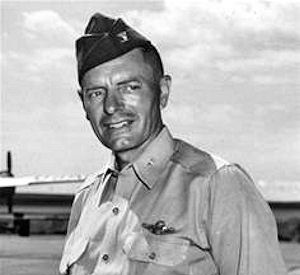Havre
In 1951 a radar station was built at Simpson, forty miles northwest of Havre. Prompted by the start of the Korean
War, the station was intended to function as a ground control intercept and warning station. Unidentified intruders picked up by radar were to be intercepted by aircraft. In 1953 the site was renamed Havre Air Force Station. Over the years, the squadron there was redesignated multiple times and the station received a number of upgrades. The station was closed in 1979.
Opheim
Like Havre’s station, Opheim AFS was built in 1951 and functioned as a ground control intercept and warning station. Along with the main facility, Opheim operated Gap Filler sites in White Water and White Tail. These were designed to fill the low-altitude gaps between manned long-range radar stations, caused by mountains, valleys, and other curvatures in the land. The station remained active until 1979.
Cut Bank
Cut Bank Air Force Station was activated in 1952 to replace the radar site at Del Bonita (along the Montana/Canada border). In addition to the station, the squadron operated Gap Filler sites at Browning and Sweet Grass. The station was closed in 1965 as part of a general reduction of Air Defense Command.
Miles City
As part of the planned deployment to create a network of 44 radar stations across the U.S. during the Cold War, Miles City Air Force Station was built in 1954. (It was expected to be operational by 1952 but constant site changes and other issues delayed deployment.) The station consisted of 60 buildings, including operation and administrative facilities, dormitories, family housing units, radar domes, and the normal support facilities/utilities. A helicopter pad and skeet range were on site, and the station also operated Gap Fillers at Glendive and Brockway. In 1968 the station’s 902nd Radar Squadron was inactivated. Today the station is the site of MSU’s Fort Keogh Livestock and Range Research Lab.
Glasgow
Glasgow Air Force Base was activated in 1957, not far from
the Canadian border. It had a “Christmas tree” alert area with bombers and tankers stationed on the runway’s “branches” next to a readiness crew building (sometimes referred to as a “mole hole”). In 1968 Glasgow AFB was taken off alert status and
the wing was inactivated. It reactivated for a short time in the 1970s as a SAC dispersal base. Boeing currently uses the base as a testing facility while the former base housing developed into the residential community of St. Marie (though most of the homes are vacant).
Lewistown
In 1958 the Lewistown Air Force Station was activated as a ground control intercept and warning station atop Judith Peak. When it deactivated in 1971 due to budget reductions, the facility was used as the campus for Big Sky Bible College. (Neither the college nor the Air Force equipment can be found on Judith Peak today.)
Great Falls
The Great Falls Air Defense Sector was established in 1959, providing command and control over several aircraft and radar squadrons. The sector was inactivated in 1966 and the command was redesignated as the 28th Air Division.

Honoring Colonel Malmstrom
The Great Falls Army Air Base was built in 1941 and renamed Great Falls Air Force Base in 1947 (when the US Air Force became a separate service). The base’s name was changed yet again in 1955 to Malmstrom Air Force Base, in honor of Colonel Einar Axel Malmstrom.
Malmstrom served as a first lieutenant in WWII, commanding the 356th Fighter Group in England. While flying his 58th combat mission in 1944, he was shot down over France and taken as a prisoner of war. (For this he was awarded the Bronze Star.) After his release, he returned to the United States in 1945 and spent the next several years serving as an air inspector for various bases.
In 1949 Malmstrom attended Air War College and upon graduating, he was assigned senior Air Force instructor at the college for three years. Later he was sent to Lockbourne, Ohio and finally, to Great Falls, Montana in 1954.
Colonel Malmstrom quickly endeared himself to the Great Falls community, serving as the vice wing commander of the 407th Strategic Fighter Wing. He had been at the base hardly six months when he was killed in the crash of a T-33 Shooting Star. The tragedy shook Great Falls. In 1955 the city renamed the Air Force base after the brave colonel.


